4 business trends shaping 2022:
- 9-to-5 freelancing
- The rise of the “on-demand” workforce
- Making or losing money with cryptocurrencies
- NFTs for business, artists and investors
9-to-5 freelancing
We know this all too well: many businesses went into downsizing to survive the pandemic. According to World Economic Forum, the COVID-19 pandemic and the resulting lockdown caused 114 million people to lose their jobs over 2020. Experts don’t expect overall employment to return to normal until the third quarter of 2023 (source).
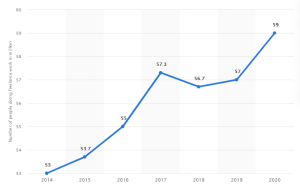
Graphic source: Siteefy
People who kept their jobs were forced to transition to working from home which came with its own set of pros and cons. Companies that didn’t adapt to this new way of working and failed to maintain employee engagement or worse, have implemented abusive employee surveillance were confronted with increasing resignation rates.
Professionals have decided that putting up with a toxic company culture on top of raising anxiety levels caused by the pandemic was simply not worth it. Some employees with small families were happy to work from home while others with different family arrangements felt that working from home was impacting their life in a negative way.
Thus the increasing number of people going into freelancing and becoming self-employed. Why work for a company that doesn’t prioritize your mental wellbeing when you can monetize your skills and experience and become your own boss?
Of course, there are specific upsides and downsides, but as the percentage in the graphic above shows, it looks like there are more advantages than disadvantages at least in this pandemic situation.
The rise of the “on-demand” workforce
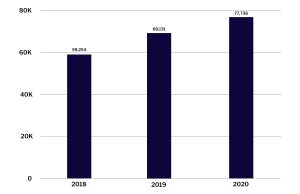
Graph source: Catalant
From Disney to Exxon to Goldman Sachs, big companies have cut jobs due to the Coronavirus. The cuts ranged from 1% to 20% of their global workforce.
Jobs still needed to get done so companies have resorted to replacing full-time employees with contract-based collaborators or freelancers.
The on-demand workforce is now in higher demand (pun intended) than in previous years. And it’s clearly a win-win situation for both workers and employers.
Hiring on-demand workers helped companies become more agile. With so many available digital platforms, it’s easier for professionals to showcase their skills and get hired project-based.
Earlier this year, a new trend within the work-from-home reality was uncovered by a Wall Street Journal report: white-collar workers working two full-time remote jobs and doubling their pay.
Making or losing money with Cryptocurrencies
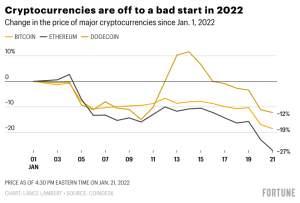
Graph source: Fortune
With people losing their jobs or getting pay cuts in the wake of the pandemic, incomes were getting thinner and thinner. For many Millennials going on the crypto market to make some money seemed like the right idea.
Prior to the outbreak of the Covid-19 pandemic, Bitcoin – the world’s first cryptocurrency – could be purchased for about $7,300. One year into the pandemic, the very same token costs more than $46,800 – a staggering 640 per cent rise (source).
At the publishing of this article, Bitcoin took another fall and is now worth $37,730. According to Binance, the total market value of all cryptocurrencies reached close to $3 trillion USD at its peak in November 2021. In Jan 2022, however, the market cap has plummeted 40%, wiping out more than $1.2 trillion USD.
Early investment in cryptocurrencies has produced several millionaires and billionaires now on Forbes’ famous list of billionaires. Others who didn’t invest early or wise, have lost large amounts of money.
NFTs for business, artists and investors
If crypto coins are the first layer of a blockchain, NFTs are the second. NFT is short for Non-Fungible Token. NFTs are digital assets that represent real-world objects like art, music, in-game items, videos and event tickets. They use blockchain technology to establish a verified and public proof of ownership.
NFTs have seen a rapid increase in awareness among artists with many selling their artworks for millions of dollars. The most expensive NFT to date is Everydays: The First 5000 Days. It was created by digital artist Mike Winkelmann (aka Beeple) and was sold for a record high of $69.3 million.
Gary Vaynerchuk, CEO of VaynerMedia and speaker at BRAND MINDS 2022 sold his NFT collection based on his doodles for $1.2 million at Christie’s auction.

The first NFT project was launched in 2015 and the interest has been growing rapidly ever since. Today the NFT market is valued at $370 billion (source: NASDAQ).
2021-2014 – NFT ideas & experiments
The idea of the NFT was implemented in 2012 on the Bitcoin blockchain. In 2014, the first NFTs were launched on Ethereum, the blockchain co-founded by Vitalik Buterin, one of the most prominent figures in the blockchain and cryptocurrency market.
2017 – the creation of Cryptokitties & CryptoPunks, cultural icons for the crypto community
The oldest and most renowned NFTs are the Cryptokitties and the Cryptopunks which were released in 2017.
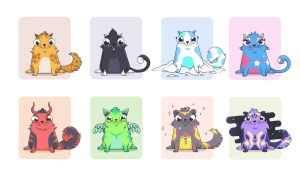
CryptoKitties (source)
CryptoKitties is a blockchain game on Ethereum developed by Canadian studio Dapper Labs that allows players to purchase, collect, breed and sell virtual cats. Only 100 in number and amid the recent NFT market resurgence, the Cryptokitties began rising in value. According to DappRadar, about $7.27 million worth of CryptoKitties NFTs were transacted over a 24-hour period.
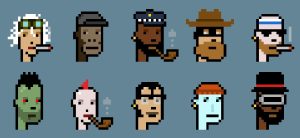
CryptoPunks (source)
CryptoPunks is a collection of 10,000 unique characters and were created by development studio Larva Labs. The characters are 24×24 pixel art images of punky-looking guys and girls, generated algorithmically. The most expensive punk is #3100 and sold for a record $7.58M. One of the latest major companies to buy a CryptoPunk is Visa, the payments technology company which paid $150,000 in Ethereum (source). To date, the lifetime total value of all CryptoPunks sales is $1.48B.
2021 – Bored Ape Yacht Club
The Bored Ape Yacht Club is a collection of 10000 unique Bored Ape NFTs— unique digital collectibles living on the Ethereum blockchain. The Bored Apes typically sell for many thousands of dollars, and some are even owned and used by celebrities as social profile pictures on Twitter. These NFT avatars are blowing up in 2021 with $750 million worth of trading volume. In September, a two-lot sale of Bored Ape NFTs brought in a combined $26.2 million at Sotheby’s.
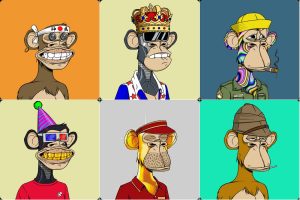
Bored Ape Yacht Club (source)
Who invented the NFT?
No individual can claim to have invented the NFT, but we know who created the first NFT. It was artist Kevin McCoy who created Quantum, the first NFT ever created. Quantum became the first work to be associated with an NFT-type certificate of ownership in May 2014, three years before the term NFT was coined.


















